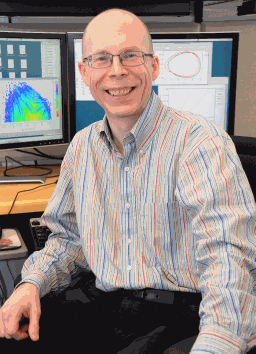Borland, who is the Associate Division Director in the U.S. Department of Energy Office of Science’s Advanced Photon Source (APS) Accelerator Systems Division, was cited for “his original contributions in creating the program ELEGANT [ELEctron Generation ANnd Tracking], and the SDDS [Self-Describing Data Sets] platform, which has marvelous impact on the design and analysis of circular accelerators, ERLs [energy-recovery linacs], and FELs [free-electron lasers]. By using ELEGANT, he predicted, for the first time, the CSR [coherent synchrotron radiation]-driven micro-bunching instability in FELs that triggered an active on-going field of research.”
The prize will be presented during the Awards Session, which will take place at the Shanghai International Convention Center during IPAC'13 on May 16, 2013, at which time Borland will give a 30-minute oral presentation covering the work for which he is receiving the prize.
Borland began work on ELEGANT while at Stanford University performing his thesis research. When he arrived at Argonne in 1991 he customized ELEGANT for use at the Advanced Photon Source. ELEGANT is now the principle simulation code used to study and improve the APS electron accelerator, the source of the high-brightness APS x-ray beams. Borland adapted ELEGANT to modeling of FELs and collaborated with researchers from the SLAC National Accelerator Laboratory on the design of the Linac Coherent Light Source, leading to his discovery of the CSR-driven microbunching instability.
Today ELEGANT is used by physicists around the world in the design and operation of storage rings, short-wavelength FELs, and other accelerator-based facilities. With ELEGANT, accelerator physicists can carry out easily performed simulated experiments that mimic those one might perform on a real accelerator.
SDDS offers access to a suite of about 70 generic data processing and display tools that can be used, together with scripting languages like Tcl to compose customized postprocessing commands. This permits, for example, users of ELEGANT to perform an arbitrary number of similar simulations without additional effort in postprocessing.
Information on ELEGANT and SDDS is available by following the links in this sentence, or by contacting Michael Borland at borland@aps.anl.gov.
The Advanced Photon Source at Argonne National Laboratory is one of five national synchrotron radiation light sources supported by the U.S. Department of Energy’s Office of Science to carry out applied and basic research to understand, predict, and ultimately control matter and energy at the electronic, atomic, and molecular levels, provide the foundations for new energy technologies, and support DOE missions in energy, environment, and national security. To learn more about the Office of Science x-ray user facilities, visit http://science.energy.gov/user-facilities/basic-energy-sciences/.
Argonne National Laboratory seeks solutions to pressing national problems in science and technology. The nation's first national laboratory, Argonne conducts leading-edge basic and applied scientific research in virtually every scientific discipline. Argonne researchers work closely with researchers from hundreds of companies, universities, and federal, state and municipal agencies to help them solve their specific problems, advance America's scientific leadership and prepare the nation for a better future. With employees from more than 60 nations, Argonne is managed by UChicago Argonne, LLC for the U.S. Department of Energy's Office of Science.

